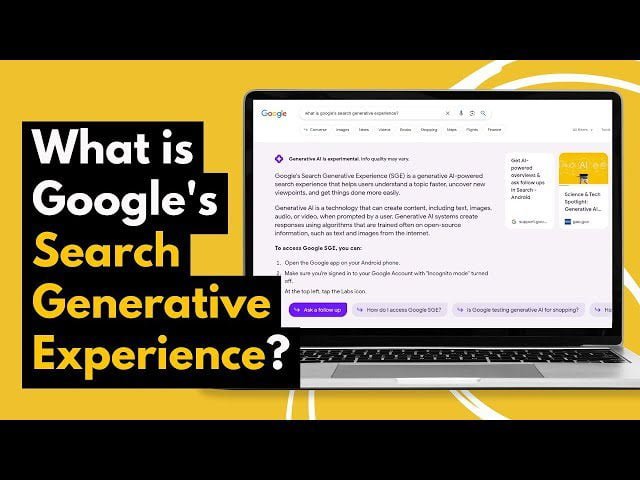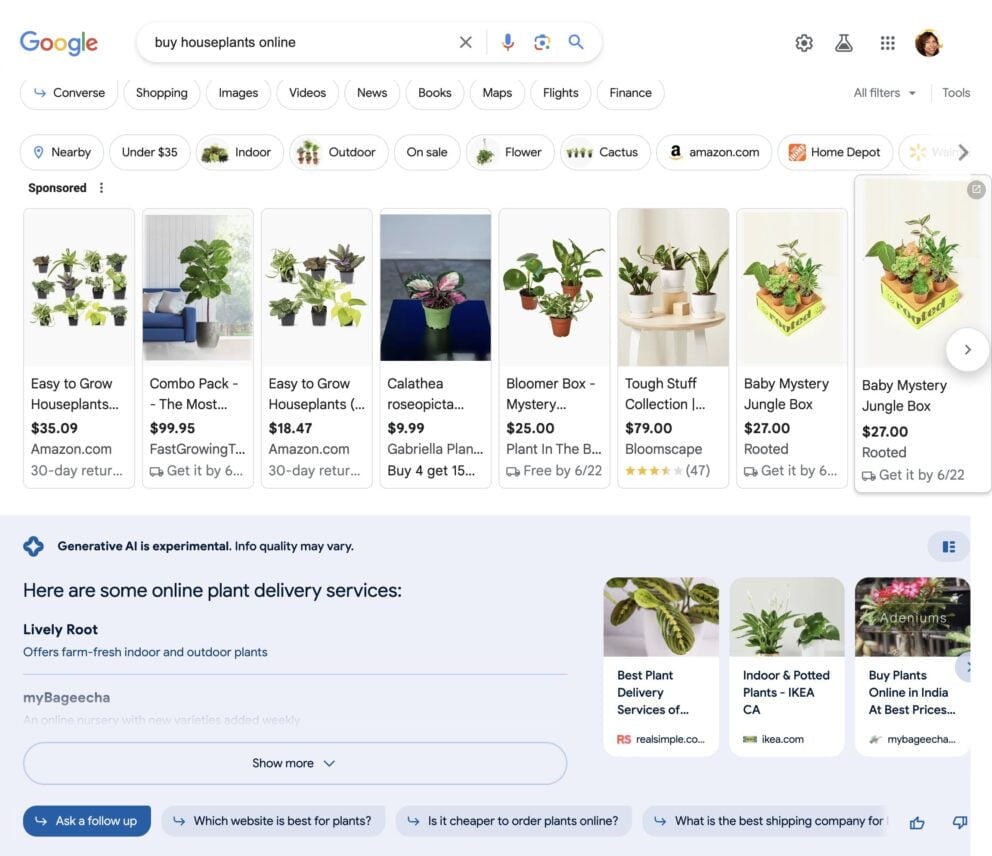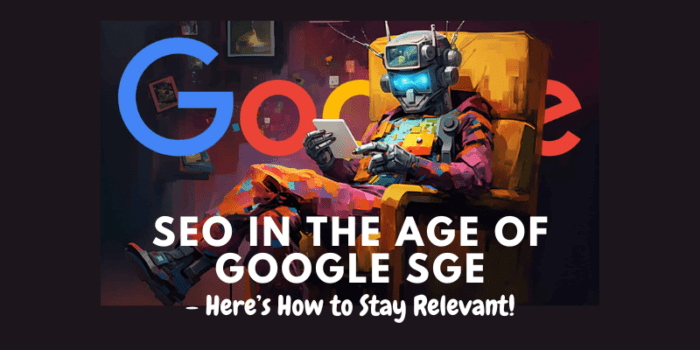So, you’ve heard of Google Search Generative Experience (SGE), right? Do you know that Google's SGE promises major shifts in SEO?
As a content creator or SEO professional, do you know how this will affect your business? And, most importantly, how are you preparing for these major shifts?
As an SEO content writer for over 8 years, I’ve witnessed a lot of Google algorithm changes and updates. In fact, I can say that in the SEO space, things change faster than you can say “long-tail keywords,” and to thrive, we must adapt. But it's not just about adapting; it's about thriving amidst the constant changes.
That is why, since Google announced the introduction of Google Search Generative Experience (SGE) and invited users to test it out, I’ve spent hours and days studying this new development with the goal of understanding how to better adapt to the changes.
In this article, I intend to share with you my understanding so far of Google Search Generative Experience (SGE), how it is shaping the future of SEO, and how you can stay ahead in the midst of the changes.
So, if this is of any interest to you, then jump in with me!
Related: How to Harness the Power of AI Marketing for Small Business Success
Table of Contents
What is Google Search Generative Experience (SGE)?

First, let’s understand what Google SGE is.
Google Search Generative Experience (SGE) is a new set of search features that incorporate results powered by generative AI into the search engine results page. With SGE, Google aims to improve the search experience by using generative AI and natural language processing (NLP) to enrich search queries with additional context, information, and visuals.
Traditionally, Google is known for its ability to provide accurate and relevant search results based on specific queries. However, with SGE, Google is introducing new elements to the search results page with the goal of providing users with a more comprehensive and interactive search experience.
In announcing this new phenomenon, here's what Google has to say,
With new generative AI capabilities in Search, we’re now taking more of the work out of searching, so you’ll be able to understand a topic faster, uncover new viewpoints and insights, and get things done more easily.
Google Search Generative Experience (SGE) leverages generative AI, a technology that enables machines to not just process information but also generate content separately. This means that when you enter a search query into Google, the results you receive are no longer solely reliant on indexed data but are infused with the creative potential of AI.
In SGE, Google's artificial intelligence (AI) algorithms play a prominent role in curating the user experience. They decide what content to display and how to present it, all in real-time.
Key Features of SGE
The key features of SGE include:
- AI-generated summary area: At the heart of SGE is the AI-generated summary area. This is a snapshot of the most relevant information related to your query. It provides you with quick answers without the need to click on links. To provide this section, SGE uses generative AI to provide a summary of information related to the search query. This summary area goes beyond the generated content by providing additional context and information, with the aim of enhancing the search experience.
- Images: SGE doesn't stop at text, it includes relevant images, graphs, and other visual elements in the search results. This makes the search results more visually appealing and informative. This feature can attract users’ attention and improve engagement.
- Links: SGE incorporates various types of links into the search results, including sponsored links, organic links that result from traditional SEO efforts, and links to more information. These links provide users with additional resources and options to explore.
- Featured Snippet: SGE includes the Featured Snippet, a prominent position on the search results page that displays a concise answer to the user's query. Optimizing content for the Featured Snippet can significantly increase visibility and click-through rates.
- People Also Ask dropdowns: SGE's predictive power shines through People Also Ask dropdowns. This feature provides related questions and answers based on the user's query, encourages users to explore further, and can drive more traffic to relevant content.
How Google's Search Generative Experience (SGE) Works
SGE starts out much like any other Google search query, with a user typing in a question or a set of terms that they are looking for information about. However, unlike what we have now, the search results generated by SGE include an AI-generated summary section with images on the right-hand side. Below this summary, users will discover links leading to more detailed information. Sponsored links, organic results, the prized Featured Snippet, and the interactive People Also Ask section follow in succession.
SGE uses AI to enhance the search experience in three ways:
- Understanding Search Intent: SGE expertly deciphers the underlying intent behind a user's query, delving deeper into the user's true information needs.
- Tailored Responses: It then crafts responses that are not only pertinent to the user's intent but also exceptionally tailored to provide comprehensive answers.
- Additional Insights: Beyond the primary response, SGE extends its value by furnishing supplementary information that users may find valuable in their quest for knowledge.
It is important to note that SGE doesn't aim to entirely replace the existing Google index; rather, it is intended to supplement it. Currently, SGE is undergoing a period of testing in line with Google's tradition of meticulously testing and refining products before rolling them out widely.
It will interest you to know that Google isn't the sole pioneer in the integration of generative AI with search. Microsoft is also dipping its toes into this transformative technology by incorporating capabilities from OpenAI's ChatGPT into its Bing search engine. This is another good reason why you should take note of this new search experience as an SEO professional.
How Does Google SGE Affect SEO?
Let’s look at how Google SGE will affect the SEO industry.
As I’ve stated above, Google Search Generative Experience (SGE) is designed to significantly alter the search engine results page (SERP). And expectedly, this will affect the user's behavior.
While we expect Google to bring in some new changes since SGE is still undergoing tests, for the moment, here are a couple ways SGE is affecting the SERP:
1. Changes in The Layout and Appearance of SERP

SGE introduces new elements to the SERP. The traditional SERP has given way to a more dynamic and visually engaging layout. These changes can impact user behavior and click-through rates.
Here's what you need to know concerning the layout:
- Layout Transformation: The SERP, once a sea of text, is now a diverse landscape. SGE introduces dynamic summaries, vivid images, and interactive elements that command user attention.
- Visual Appeal – Visual content takes center stage. Users are greeted not only with text but with eye-catching images, graphs, and infographics. This visual flair enhances the user experience and helps convey information more effectively.
- Rich Link Ecosystem – The links on SGE are diverse, catering to various user needs:
- Sponsored Links that allow advertisers to secure prominent positions.
- Organic Links, which are the result of traditional SEO efforts, now compete with the visual and AI-powered elements for user clicks.
- Featured Snippets, which are concise answers to common queries and often placed above traditional search results, aim to provide immediate value to users.
2. Impact On User Behavior and Click-Through Rates
SGE aims to enhance the search experience by providing additional context, information, and visuals. The AI-generated summary area and Featured Snippet can provide users with a quick answer to their query, reducing the need to click through to other pages. On the other hand, the inclusion of images and links can attract user attention and encourage exploration.
Here are some of the ways that these changes will impact user behavior:
- Extended Stay on SERP – Users may spend more time on the SERP itself, absorbing information without clicking through to websites. This will definitely affect website traffic.
- Implications for Click-Through Rates (CTR) – The traditional metric of CTR may lose some of its significance. This will impact how we measure the effectiveness of SEO strategies.
- User Intent Focus – SGE aligns with user intent, presenting answers promptly. SEO strategies must pivot to satisfy this intent and offer value even before users navigate to a specific website.
SEO professionals need to understand and adapt to these changes to optimize their content for SGE if they want to stay ahead in the evolving SEO landscape.
Recommended: How to Measure SEO Performance Like a Pro (Even if You’re Just a Beginner)
Potential Challenges of SGE for Search Engine Optimization
So, what are the challenges for content creators and SEO professionals? Well your guess is mine!
Thus far, test results show that Google SGE has a lot of implications for SEO. It’s important therefore that as content creators and marketers, we begin to adjust our content optimization strategies to align with these changes.
Here are some of the potential challenges for SEO professionals:
- Increased Competition: With SGE's dynamic and visually appealing SERP, competition for a user's attention has intensified. Besides, SEO professionals will find themselves competing not just with other websites but with Google own AI-generated content. This requires a shift in content creation and optimization strategies since the AI-generated summaries may answer user’s queries, reducing the need to visit a website.
- Limited Space: The SERP real estate is finite, and SGE introduces elements like sponsored links, featured snippets, and visual content. This limits the number of traditional organic search results, making it harder for websites to secure prominent positions.
- Diversification of content strategies beyond blogs: SGE encourages a diversification away from relying solely on blog content. SEO professionals should explore different types of content, such as videos, social media posts, and brand websites, to maximize their visibility on the SERP. This requires a shift in content creation and optimization strategies.
- Content Relevance – SEO professionals are faced with the challenge of optimizing content not just for search engine algorithms but for the discerning eyes of AI-powered search. The focus is now on creating content that fits within the SGE framework, offering value in concise, conversational snippets.
As you can see from the above, SGE has real challenges for SEO. However, there are also new opportunities.
Recommended: How to Write a Blog Post for SEO Using ChatGPT (The Ultimate Guide)
Opportunities in SGE for SEOs

With Google Search Generative Experience (SGE) reshaping the digital landscape, SEO professionals need not just weather the storm but sail on its currents to reach new horizons. Below are some of the opportunities for SEO professionals in this new era of Google Search Generative Experience (SGE):
- Leveraging AI features and visuals in SGE: SEO professionals can optimize their content to take advantage of the AI-generated summary area, images, and other visual elements in SGE. By creating visually appealing and informative content, they can increase their chances of attracting user attention and clicks.
- Optimizing for organic links and Featured Snippets: SGE includes organic links and the Featured Snippet, which are valuable real estate on the SERP. SEO professionals should focus on optimizing their content to appear in these prominent positions, as they can drive significant traffic and visibility.
- Expanding reach through brand websites and social media integration: With SGE, brand websites have the opportunity to appear in search results alongside publisher websites. SEO professionals should ensure that brand websites are optimized for search and work closely with social media teams to integrate SEO strategies with social media efforts.
- Emphasizing user experience and relevance in content creation: With SGE, user experience and relevance become even more critical factors in SEO. SEO professionals should focus on creating high-quality, informative, and engaging content that meets the needs of their target audience. By prioritizing user experience, they can increase their chances of ranking well in SGE.
- Collaboration with other marketing channels: SEO professionals should work closely with social media teams and other marketing channels to leverage the inclusion of LinkedIn articles, tweets, and TikTok links in search. Collaboration can help amplify the reach and impact of SEO efforts and ensure a cohesive marketing strategy.
As we can see, Google SGE is not a threat; it's a wave of change that SEO professionals can ride to success. SEO professionals have opportunities to leverage AI features and visuals in SGE, optimize for organic links and Featured Snippets, expand reach through brand websites and social media integration, emphasize user experience and relevance in content creation, and collaborate with other marketing channels to maximize their visibility and impact in the evolving SEO landscape.
Recommended: How to Optimize Content for SEO Using Rank Math (In 7 Easy Steps)
Recommendations for Staying Ahead in the Evolving SEO Landscape
Having understood how SGE affects SEO and the challenges it poses for the SEO industry, let’s now consider a few things that you can do in order to stay relevant in this evolving SEO landscape.
Of course, SGE is still in its development stage and Google will definitely change or, even drop a few things in the course of time, but you can prepare yourself to not only survive but thrive in this ever-evolving terrain by adopting these recommendations:
1. Continuous Monitoring and Adaptation of SEO Strategies
- Stay Informed: The SEO landscape is constantly changing. Make it a habit therefore to stay updated with the latest developments in SGE and search engine algorithms. Subscribe to industry blogs, follow SEO experts on social media, and attend webinars and conferences.
- Monitor Performance: Regularly assess the performance of your SEO strategies within the SGE framework. Use tools to track your rankings, click-through rates (CTR), and user engagement. Identify what's working and what needs adjustment.
- A/B Testing: Experiment with different SEO strategies, content formats, and keywords. Conduct A/B tests to determine which approaches resonate best with SGE's evolving user base.
2. Keeping Up with SGE Updates and Quality Improvements
- SGE Updates: Google's Search Generative Experience (SGE) is still in development, and updates and quality improvements are expected. Just as SEO professionals keep an eye on Google algorithm updates, they should also track SGE updates. Google often refines its AI algorithms and user experience. Be prepared to adapt to these changes.
- Quality Matters: SGE places a premium on high-quality content. Ensure that your content is well-researched, accurate, and provides value to users. Focus on in-depth, comprehensive pieces that thoroughly address user queries.
- User Intent Analysis: Dive deep into understanding user intent. Create content that aligns with the intent behind different search queries. This involves researching and anticipating what users want to know.
3. Emphasizing User Experience and Relevance
- Mobile Optimization: With mobile devices being a prominent entry point for users, ensure your website is mobile-friendly. Responsive design and fast loading times are crucial for a positive user experience.
- User-Centric Content: Craft content with the user in mind. Prioritize clarity, readability, and conciseness. SGE users often seek quick answers; your content should provide these while also offering in-depth insights for those who want more.
- Interactive Elements: Experiment with interactive content like quizzes, calculators, and surveys. These engage users and keep them on your website longer.
- Stay compliant: SEO trends are evolving to include voice search optimization, artificial intelligence, experience, expertise, authoritativeness, and trustworthiness (E-E-A-T), and Your Money or Your Life (YMYL) compliance. SEO professionals should prioritize these factors in their strategies to stay ahead in the evolving SEO landscape.
4. Collaboration with Other Marketing Channels
- Cross-Departmental Collaboration: SEO should no longer be siloed. Collaborate closely with other departments, especially social media and marketing teams. Ensure your SEO efforts align with broader marketing and brand strategies.
- Content Creators and Marketers: Foster collaboration between SEO professionals and content creators. Content should be optimized not just for search engines but also for users and social sharing.
5. Focus on ROI-Centric Approach
- Measure ROI: As SEO strategies evolve in the SGE era, focus on measuring the return on investment (ROI) of your efforts. Determine how your SEO activities contribute to the overall goals and revenue of your organization.
- Data-Driven Decisions: Rely on data to make informed decisions. Analyze the impact of your SEO strategies on traffic, conversions, and revenue. Use this data to refine and optimize your approach continually.
These recommendations are not exhaustive but I believe if you follow them and remain adaptable, you can navigate the evolving SEO landscape with confidence and success.
FAQs About Google Generative AI and SEO
How do I enable generative AI on Google?
To enable generative AI through Google's Search Generative Experience (SGE), you must first understand that it's currently accessible to a limited group of users within the United States. To get on the waitlist for SGE, sign in to your Google account, search for “Google SGE waitlist,” and click on the official link to join. Fill in your name, email, location, and briefly explain your interest. Once you've submitted your details, you'll receive confirmation that you're on the waitlist, and Google will notify you when SGE becomes available to you. Remember that access is gradually expanding, so even if you're not in the initial group, you may gain access in the future by staying updated on Google's official announcements.
Is generative AI free?
The availability of free generative AI services varies depending on the particular application. Certain tools and platforms harnessing generative AI capabilities may offer free access, whereas others might necessitate a subscription or payment. Take, for instance, Google's Lookout app for Android, which leverages generative AI to provide insights into image-based queries. This app is readily accessible for free, allowing users to download and utilize it without any cost.
What programming language does Google use for AI?
Google employs a diverse array of programming languages in the realm of AI, encompassing Python, C++, Java, and Go among others. The choice of a particular programming language hinges on the specific application at hand and the expertise of the team responsible for its development.
Can I use AI content for SEO?
Yes, AI-generated content can be harnessed effectively for SEO purposes, as long as it aligns with the established quality benchmarks applied to all content. Nevertheless, it's crucial to acknowledge that AI-generated content may occasionally yield inaccuracies or unsuitable outcomes. Consequently, meticulous review and editing of the content prior to publication remain essential steps to ensure its suitability and accuracy.
Where can I study generative AI?
A multitude of educational avenues exist for delving into generative AI. These include online courses, tutorials, and literature resources. Renowned online learning platforms such as Coursera, Udacity, and edX stand out as popular choices for AI education. Furthermore, Google provides an array of learning resources for aspiring AI enthusiasts, comprising research papers, informative blog posts, and access to open-source software, contributing to a comprehensive learning experience in the field.
Conclusion: Embrace the Google SGE Era for SEO Success
Alright, there you have it, my insight into Google’s Search Generative Experience (SGE) and its profound impact on the SEO industry. While we have looked at the intricacies of Google SGE and its changes to the SERP, there’s no guarantee that Google will not refine and enhance SGE based on user feedback and usage patterns. But for now, you can brace yourself for these changes by adjusting your SEO strategies.
Yes, SGE presents some challenges but it also offers some opportunities. As a content creator and SEO professional, you can expand your reach by leveraging SGE AI features and optimizing your content for organic links and Featured Snippets.
You can now also take advantage of your social media marketing efforts in a bigger way by simply integrating them with your other marketing channels.
I hope you find this deep dive into Google SGE useful. Google SGE may still in the experimental stage but you can trust that this is going to be the future of Google search. So, prepare yourself today to adjust to the new changes that will come with Google’s Search Generative Experience (SGE)!
What are your thoughts about Google SGE? Share them with us in your comments below.







